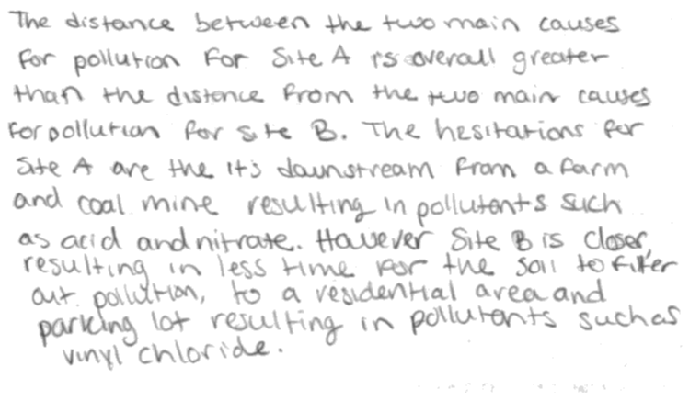PART 1
The “Map of Water System” shows two sites—Town Site A and Town Site B—that are being considered for the location of a new town. The locations for the drinking water sources for the potential sites are marked on the map as SA and SB. Your task will be to determine, based on the quality of available drinking water from a nearby river, which of the two sites is a better location for the town. You will also consider which water treatment processes will be needed at the new town site.
You have been given water samples from the sites that you will test for certain pollutants and compare your findings to national drinking water standards. You will test for some of these pollutants and use the results of tests from an outside laboratory for others.
Before testing the water samples, make a prediction about which potential town site (A or B) you think would have better water quality. Because you have not tested the water samples SA and SB yet, your prediction will be based on the information on the "Map of Water System" and "Reference Chart 1" in your kit.
Prediction (choose one site):
A. Town Site A
B. Town Site B
Explain why you chose the town site you did and not the other town site. Support your explanation using only the information provided on the "Map of Water System" and "Reference Chart 1."
Keep the other charts for a later part of the task.
Sample complete student response:

Scoring Guide
Complete:
Student response selects (A) or (B), and provides a correct explanation that consists of two parts:
- Names at least one specific type of water pollutant (e.g., dioxin or acid drainage from column 2 of Chart 1) that is unique to one site.
- Provides a plausible argument for selecting one site instead of the other, which may include that the other site is downstream from the specific sources of water pollutants, the sources of water pollutants are farther away from the site selected, the water pollutants at the site selected are less harmful, easier to filter, or fewer water pollutants at the site selected.
OR
Student response selects (A) or (B), and names at least two specific types of water pollutants (e.g., dioxin or acid drainage from column 2 of Chart 1), one unique to each site.
Partial:
Student response selects (A) or (B), and makes a reference to water pollutants, which may include naming specific pollutants that are common to both sites, such as nitrates, heavy metals, or iron, or providing the sources of water pollutants such as agricultural areas at Town Site A and residential areas at Town Site B. Explanation may or may not include a plausible argument for the site selected.
OR
Student response selects (A) or (B), and names at least one specific type of water pollutant (e.g., dioxin, acid drainage) that is unique to one site, but does not provide a plausible argument for the site selected.
Unsatisfactory/Incorrect:
Student response is inadequate or incorrect.
Percentage of twelfth-grade students in each response category: 2009
| Complete |
Partial |
Unsatisfactory/ incorrect |
Omitted |
|---|
| 13 |
50 |
36 |
1 |
|---|
SOURCE: U.S. Department of Education, Institute of Education Sciences, National Center for Education Statistics, National Assessment of Educational Progress (NAEP), 2009 Science Assessment.